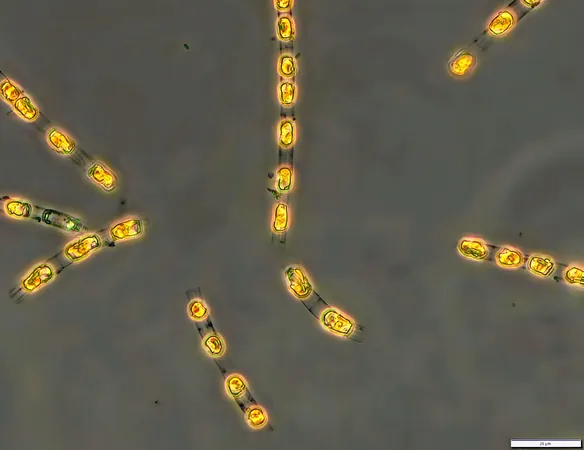
Remarkable Discovery: 7,000-Year-Old Algae Brought Back to Life from the Baltic Sea!
2025-03-31
Author: Wei Ling
An Extraordinary Breakthrough
In an extraordinary scientific breakthrough, researchers have successfully resurrected ancient algae that lay dormant at the bottom of the Baltic Sea for nearly 7,000 years. This remarkable feat offers a unique glimpse into ancient ecosystems, providing an unprecedented opportunity for scientists to study life from nearly a millennium ago.
A Hidden Time Capsule Beneath the Waves
Leading the charge is the Leibniz Institute for Baltic Sea Research Warnemünde (IOW), as part of the innovative PHYTOARK project. Their goal? To unravel the historical ecological shifts of the Baltic Sea and what those changes mean for its future. What they found is nothing short of astonishing.
The deep-sea sediment where these algae were discovered acts as a time capsule. Dormant organisms, from bacteria to larger marine life, can survive extreme conditions by entering a state of dormancy, where they essentially "sleep." For phytoplankton—a critical component of marine ecosystems—this means forming resistant, resting stages that become buried in sediment. In the cool, dark, and oxygen-free depths of the sea, these microscopic plants can remain inactive for millennia.
According to Sarah Bolius, a phytoplankton expert at IOW and the lead author of the study, "Such deposits are like a time capsule containing valuable information about past ecosystems, their biological communities, population development, and genetic changes."
Algae Thriving from the Depths of Time
The research team extracted sediment cores from the Eastern Gotland Deep, allowing them to obtain dormant phytoplankton resting stages from sediment layers linked to different climate phases in the Baltic Sea’s history.
Using carefully controlled lab conditions that mimicked natural light and nutrient availability, the scientists "woke up" algae from nine different layers, with surprises around every corner.
The standout star of the study was Skeletonema marinoi, a widely prevalent diatom in the Baltic Sea known for flourishing during spring algal blooms. Remarkably, this species revived from every sediment layer tested, including one that is estimated to have been buried for 6,871 years!
The revival of these ancient algae was not just a trick of survival; they thrived, demonstrating biological activity comparable to their modern relatives. Bolius noted, "They grow, divide, and photosynthesize like their modern descendants." The ancient samples exhibited impressive growth rates—a staggering 0.31 cell divisions per day—along with strong photosynthesis, producing oxygen levels akin to what we see today.
Moreover, genetic testing revealed that these rejuvenated algae formed unique genetic groups based on the layers they came from. This indicates that the populations of S. marinoi in the Baltic Sea have undergone significant genetic changes over millennia.
Pioneering Resurrection Ecology
This groundbreaking approach is a part of the emerging field of "resurrection ecology," which focuses on reviving ancient organisms to examine how they have altered over time. Previously, similar successes had only been recorded with a handful of plant seeds and crustaceans; the revived S. marinoi strains are now among the oldest known living organisms reactivated from aquatic sediments.
"This significant success in reactivating such old algae from dormancy marks an important step forward in developing the 'Resurrection Ecology' tool in the Baltic Sea," Bolius emphasized. Scientists are now equipped to conduct "time-jump experiments" in the lab, enabling them to explore various stages of the Baltic Sea’s historical development.
Such experiments could be pivotal in reconstructing past environmental conditions and in tracking the long-term evolutionary responses to varying salinity, temperature, and oxygen levels.
Linking Climate Insights with Living History
In an age when climate change is reshaping marine ecosystems, this research presents a unique opportunity to understand how species might have adapted to past episodes of warming and cooling. The chance to study living cells instead of just relying on fossil evidence or degraded DNA is revolutionary for evolutionary biology and paleoecology.
This study illustrates the possibility of tracing genetic changes over thousands of years through the analysis of living cells, offering an invaluable window into our planet's biological history.
Future research endeavors will expose the revived algae to diverse environmental conditions, seeking insight into how their genetic and physiological traits have helped them withstand the test of time.
Ultimately, the astounding resilience of these ancient diatoms not only emphasizes the adaptability of life but also highlights the importance of sediment cores as archives of our planet's biological history. As Bolius and her colleagues continue to delve into these mysteries, their work promises to illuminate the intricate relationship between climate, evolution, and the remarkable tenacity of life hidden beneath the sea.
Publication and Future Endeavors
This study has been published in the prestigious ISME Journal and stands as a testament to the resilience of nature and the insights that can be gleaned from the depths of our oceans. Stay tuned for more groundbreaking discoveries in the realm of marine science!


 Brasil (PT)
Brasil (PT)
 Canada (EN)
Canada (EN)
 Chile (ES)
Chile (ES)
 Česko (CS)
Česko (CS)
 대한민국 (KO)
대한민국 (KO)
 España (ES)
España (ES)
 France (FR)
France (FR)
 Hong Kong (EN)
Hong Kong (EN)
 Italia (IT)
Italia (IT)
 日本 (JA)
日本 (JA)
 Magyarország (HU)
Magyarország (HU)
 Norge (NO)
Norge (NO)
 Polska (PL)
Polska (PL)
 Schweiz (DE)
Schweiz (DE)
 Singapore (EN)
Singapore (EN)
 Sverige (SV)
Sverige (SV)
 Suomi (FI)
Suomi (FI)
 Türkiye (TR)
Türkiye (TR)
 الإمارات العربية المتحدة (AR)
الإمارات العربية المتحدة (AR)